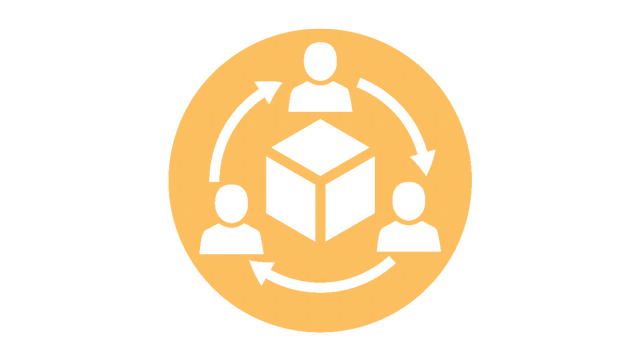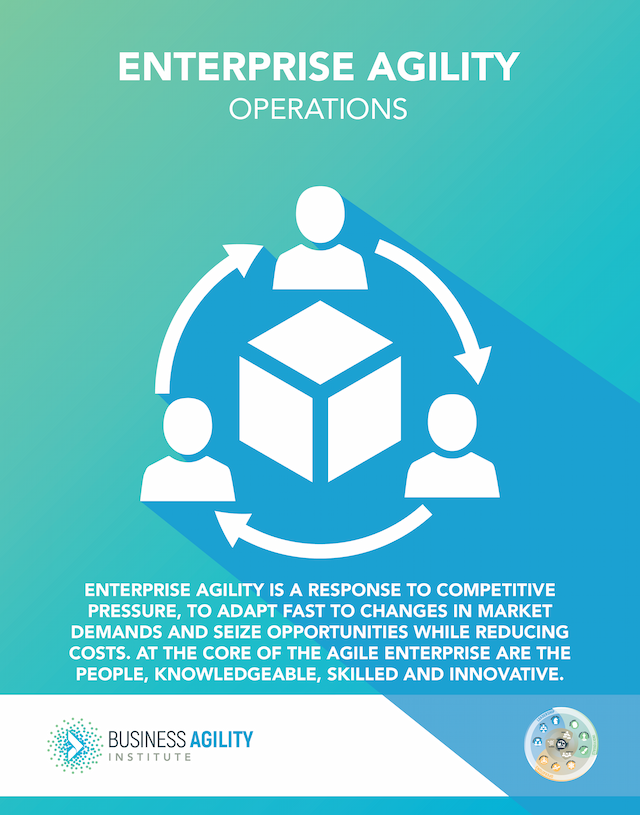Domains of Business Agility
- Customer
- / Customer
- Leadership
- / People Management
- / One Team
- / Strategic Agility
- Individuals
- / Growth Mindset
- / Craft Excellence
- / Ownership & Accountability
- Operations
- / Structural Agility
- / Process Agility
- / Enterprise Agility

Enterprise Agility
01 Introduction
Enterprise Agility is a response to competitive pressure, to adapt fast to changes in market demands and seize opportunities while reducing costs. At the core of the Agile Enterprise are the People, knowledgeable, skilled and innovative.
Agile success at the Team level triggered the desire for Enterprise Agility as a discrete domain and the nest level of Agile transformation. Over the last decades, as teams became agile, the constraining factor for to scale agility was the other teams within the business unit. Now, as entire business units become agile, the constraining factor for agility is the rest of the organization. The ultimate goal of Enterprise Agility transformation is to transform the whole organization in an Agile Enterprise.
“An organization can only be as agile as its least agile division!”
— Evan Leybourn, Evan’s Theory of Agile Constraints
Enterprise Agility emerges when there is an Agile way of working across the entire organization, when each business unit reaches their required level of Agility. From a systems perspective, it can help to think of work in your organization as a flow, from market demand to delivery to customers. Somewhere along this flow is the next limiting constraint that will challenge business agility. To take advantage of Agility benefits, it is mandatory that the mindset change spreads beyond IT with PMO, HR, Sales and Finance the obvious next targets. The history demonstrate that Agile frameworks and practices were developed to respond to a fast changing and demanding market, rather than being artificially created as academic concepts. The Agile Enterprise is based on empiricism, by "uncovering better ways of developing products by doing it and helping others do it". Experimenting new ways and learning from the past is how Agility can become the norm at the enterprise level, from the CEO to the production floor.
These are not easy problems to solve. You must help these divisions internalize an agile mindset and culture as well as providing appropriate practices aligned with their work context. This is key to achieving Enterprise Agility and ultimately true business agility.
02 Moving from Theory to Practice
Your goal is to bring agility across the organization; from IT, Finance, HR, Marketing, Sales, and Operations.
Create a Value Stream Network
Value stream maps are great for processes, however, in an organizational context with many inter-dependencies you have to build a Value Stream Network; which is a high-level network of different business processes and how they interact across the organization. For the purposes of transformation, keeping it high-level is usually sufficient. Then, by introducing measures to each of your processes across the network you can identify (and hopefully resolve) enterprise bottlenecks. One caveat though, mapping a process that shouldn’t exist may give it unwarranted validity. Remember that the purpose of mapping the organization is to eliminate bottlenecks and simplify complex processes.
Create an Adaptive Portfolio
Start by creating an adaptive portfolio; which is a managed list of major ideas, aligned by business outcome and ranked. Initiatives are then “pulled” by a team when they have the capacity, rather than forming temporary teams around work.
This doesn’t mean that we shouldn’t have strategic goals, nor does it negate the need for planning, but it does change the approach to planning. Strategic goals look out a year or more which then get translated into initiatives. Each initiative will have milestones and checkpoints to ensure the work being done aligns back to the organization’s goals and that our people and resources are being deployed in the wisest way possible.
Fund Outcomes or Teams
Traditional organizations fund projects based on the estimated effort & duration of a fixed scope of work (which is often incorrect) and with benefits measured after the project is complete. Instead, start to fund initiatives based on a steady rate of financial spend against a regularly measured business outcome. There is still an assumption made around the return on investment, but the period of measure is exponentially shorter. By dynamically planning, prioritizing, and monitoring activities against outcomes, teams can manage their spending and deliver the highest value activities first.
Because we have greater predictability and can focus on value realization rather than measuring outputs, we’re in a much stronger position to demonstrate value to customers and shareholders.
03 Measuring your Business Agility Maturity
Crawl
Walk
Run
Fly
Funding Models
All work (e.g. projects or products) has an assumed, predetermined, & quantifiable value to the organization in the context of a business outcome. We use this information to justify, prioritize, and fund the work.
Strategic goals have incremental checkpoints to ensure that all work aligns with our organization’s goals.
All our business outcomes have relative targets and regular measures (including non-financial measures). We are able to quickly and easily start, pivot or stop work, projects, or products.
We use adaptive funding models to allocate funds against value streams (rather than projects). We align governance and feedback loops to business (or customer) outcomes (rather than time, cost or scope measures).
Supporting Functions
At least 2 divisions have changed the way they work to be enablers and collaborators to others. This has had a positive impact on the business and feels more agile.
We have identified those business functions that limit (or constrain) the agility of our organization (through excessive process & governance, limited capacity or other reasons). We are actively working to remove the constraint.
Supporting functions enable business agility within our organization by actively supporting teams and creating simplified (and open) processes (e.g. Netflix’s expense policy – “Act in Netflix’s Best Interest”).
Each department understands they have an internal or external customer that they need to delight and are actively doing so.

